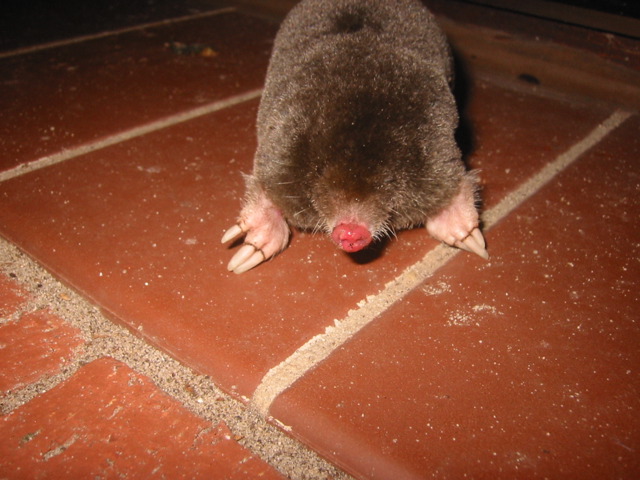Ammunition for the War on Moles and Voles
go.ncsu.edu/readext?945548
en Español / em Português
El inglés es el idioma de control de esta página. En la medida en que haya algún conflicto entre la traducción al inglés y la traducción, el inglés prevalece.
Al hacer clic en el enlace de traducción se activa un servicio de traducción gratuito para convertir la página al español. Al igual que con cualquier traducción por Internet, la conversión no es sensible al contexto y puede que no traduzca el texto en su significado original. NC State Extension no garantiza la exactitud del texto traducido. Por favor, tenga en cuenta que algunas aplicaciones y/o servicios pueden no funcionar como se espera cuando se traducen.
Português
Inglês é o idioma de controle desta página. Na medida que haja algum conflito entre o texto original em Inglês e a tradução, o Inglês prevalece.
Ao clicar no link de tradução, um serviço gratuito de tradução será ativado para converter a página para o Português. Como em qualquer tradução pela internet, a conversão não é sensivel ao contexto e pode não ocorrer a tradução para o significado orginal. O serviço de Extensão da Carolina do Norte (NC State Extension) não garante a exatidão do texto traduzido. Por favor, observe que algumas funções ou serviços podem não funcionar como esperado após a tradução.
English
English is the controlling language of this page. To the extent there is any conflict between the English text and the translation, English controls.
Clicking on the translation link activates a free translation service to convert the page to Spanish. As with any Internet translation, the conversion is not context-sensitive and may not translate the text to its original meaning. NC State Extension does not guarantee the accuracy of the translated text. Please note that some applications and/or services may not function as expected when translated.
Collapse ▲It’s one of those lovely, sunny days that invites you out to the garden. You make your way around planting beds just coming to life after a long winter but wait, where are those tulips you planted last fall? You notice, to your dismay, little trails or mounds in the soil, and perhaps little holes here and there. If you haven’t met them before, you’re about to become acquainted with a pair of furry little critters that just love your garden: moles and voles.
Moles
Voles are not the only pests responsible for runways in the garden and they’re often confused with those other fellows you’d like to get rid of: moles. Moles make two types of runways in your yard. One is just beneath the surface, called feeding tunnels. These are the raised ridges that usually alert you to their presence. Others are deep below the surface and act to connect the feeding tunnels. The soil excavated from these tunnels forms the mounds distributed where moles have been active. Voles, however, leave no mounds.
While there are some similarities between moles and voles, they are fundamentally very different creatures. Moles could be considered beneficial. They characteristically have a large snout. They have the ability to tunnel with their

Mole
modified paws. Their tunnels beneath the soil surface can act to aerate the soil. Moles also eat insects, grubs, and earthworms, rather than plants. Moles don’t intentionally harm plants, although their tunnels may dislodge roots and cause those plants to dry out more quickly.
Pine Voles
Voles are smaller than moles, about the size of a mouse. They sometimes dig tunnels, but they are also opportunists and have been known to travel about in those tunnels previously dug by moles.
In NC we have two types of voles: pine voles and meadow voles. The pine vole, Microtus pinetorum, is becoming a bigger problem in the home landscape as increased development reduces their natural habitat and they become more adapted to our backyards. These are the prime suspects for the missing tulip bulbs.
Pine voles are reddish brown and small, 2-4 inches long, with a short tail, blunt face, and tiny eyes and ears. They feed mainly on roots and tubers of plants that do not have poisonous tissues. They spend much of their time under leaf litter or in their underground burrows. They don’t hibernate and, even though we rarely see them, they are active day and night. Their lifespan averages anywhere from two to 16 months. A pair of voles can have up to six litters a year, with two to four young per litter. Pine voles are monogamous and family units tend to maintain territories as small as 1000 square feet and remain there for their entire short lives. So, you can see, when they arrive and set up housekeeping in your garden, you’d be wise to step up to (or on to) the challenge.
Taking Action
In the ongoing wars to protect the gardener’s tender and precious plantings from the ravages of voles, a myriad of attack weapons have been developed, humane and otherwise. Just check out the shelves of your favorite lawn and garden store or the online catalogs: these include repellants (short-term results only), devices (don’t work), rodenticides (designed to kill mammals…think pets), baits and traps.
The extent of plant loss or damage in relationship to vole populations should be considered when choosing which way to approach the problem. Safe and non-toxic methods like exclusion, the installation of underground physical barriers, have proven to be effective because voles aren’t fond of getting cut or injured. These methods generally don’t involve chemicals and are safe to use in the presence of humans, pets, and wildlife. However, reduction in natural vole habitat also reduces habitat for their natural predators (owls, hawks, snakes, etc.). These predators depend on rodents as a food source and possess sensory abilities for locating their meals.
We know and are grateful for the fact that voles are not fond of daffodils. But, when you try again (and you will, you know) to develop that lovely bed of tulips or other savory plantings, you might want to try a safe and humane approach. Incorporating coarse particles like expanded slate into the beds has proven to be an effective barrier to pine voles. Some have found it helpful to mix sharp-edged pea gravel throughout the soil as they prepare a new planting bed. Products such as Perma-Till and VoleBloc can be useful deterrents when used in this way. While not cheap, these methods do not pose ongoing risks to the environment or to the neighbor’s favorite pet.
Updated from the April 9, 2014 article by Celeste M. Bissell, who was the president of the Extension Master Gardener Volunteers at North Carolina Cooperative Extension in Lee County.
Resources:




